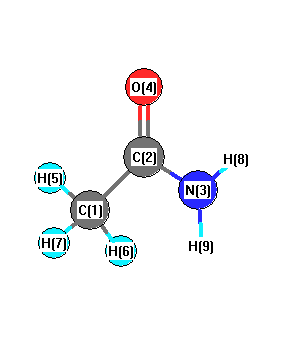.
| squib |
reference |
DOI |
| 1973Kit/Kuc:3048 |
Kitano, M., Kuchitsu, K., Molecular Structure of Acetamide as Studied by Gas Electron Diffraction, Bulletin of the Chem. Soc. Of Japan, Vol. 46, pgs. 3048-3051 |
10.1246/bcsj.46.3048 |
| 1998Gus/Rui:163 |
M Gussoni, R Rui, G Zerbi "Electronic and relaxation contribution to linear molecular polarizability. An analysis of the experimental values" J. Mol. Struct. 447 (1998) 163-215 |
10.1016/S0022-2860(97)00292-5 |
| 1998Samdal:165 |
Samdal. Acetamide, a challenge to theory and experiment? On the molecular structure, conformation, potential to internal rotation of the methyl group and force fields of free acetamide as studied by quantum chemical calculations. J. Mol. Struct. Vol. 440. pgs. 165-174. |
10.1016/S0022-2860(97)00264-0 |
| 2001Sue/Gol:188 |
RD Suenram, GY Golubiantikov, II Leonov, JT Hougen, J Ortigoso, I Kleiner, GT Fraser "Reinvestigation of the Microwave Spectrum of Acetamide" J. Mol. Spect. 208, 188-193, 2001 |
10.1006/jmsp.2001.8377 |
| 2002Yam/Hag:144 |
A Yamaguchi, S Hagiwara, H Odashima, K Takagi, S Tsunekawa "The Microwave Spectrum of Acetamide (CH3CONH2) in the Frequecny Range from 12 to 200 GHz" J. Mol. Spec. 215, 144-154, 2002 |
10.1006/jmsp.2002.8612 |
| NSRDS-NBS10 |
R. D. Nelson Jr., D. R. Lide, A. A. Maryott "Selected Values of electric dipole moments for molecules in the gas phase" NSRDS-NBS10, 1967 |
10.6028/NBS.NSRDS.10 |
| TRC |
Frenkel, M; Marsh, K.N.; Wilhoit, R.C.; Kabo, G.J.; Roganov, G.N.,Thermodynamics of Organic Compounds in the Gas State,Thermodynamics Research Center, College Station, TX, 1994 |
|
| webbook |
NIST Chemistry Webbook (http://webbook.nist.gov/chemistry) |
10.18434/T4D303 |











